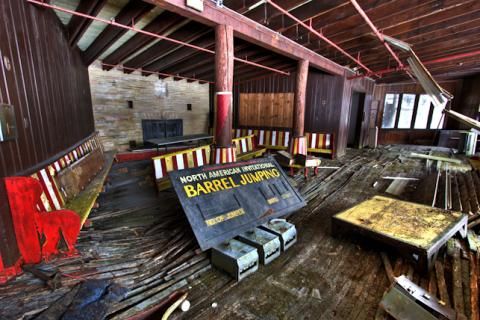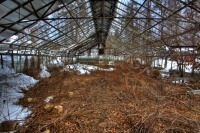
Above: A photo of one of the many scenes of the abandoned Grossinger's resort.
The first time Jonathan Haeber heard of Grossinger's, he was reading Maus, the acclaimed graphic novel about the Holocaust by Art Spiegelman. Part of the story is set at the once-grand Catskills resort, and that little glimpse of bygone Borscht Belt glamour immediately had Haeber hooked.
A 29-year-old Californian photographer and armchair historian, Haeber makes a hobby of abandoned places. (You can read about his adventures on his blog, Bearings.) After his introduction to Grossinger's, Haeber flew across the country to research its history. He interviewed Grossinger's employees and family members, read scores of books, and visited and explored the husk of the overgrown Liberty resort itself. Now, Haeber's passion for Borscht Belt history has become a book, Grossinger's: City of Refuge and Illusion, which was published by Furnace Press in November. We talked with Haeber about the book, an excerpt from which you can read below.
Now, Haeber's passion for Borscht Belt history has become a book, Grossinger's: City of Refuge and Illusion, which was published by Furnace Press in November. We talked with Haeber about the book, an excerpt from which you can read below.
Watershed Post: How did you get into the Grossinger's site?
Jon Haeber: It was easier than 99 percent of the other stuff I've been to. It used to be really easy to walk in – you could park your car and walk inside. After it became more well-known, the state troopers came in. The city [of Liberty] itself is trying to pressure the owner of the land to fence off the entire resort complex. I think they're just worried about being sued. I think it will either be demolished very soon or it will be fenced off.
 WP: Why Grossinger's? Most people who have read Maus haven't driven up the Catskills to explore the bones of the old resort where it was set. It's an especially long way to come for a Californian.
WP: Why Grossinger's? Most people who have read Maus haven't driven up the Catskills to explore the bones of the old resort where it was set. It's an especially long way to come for a Californian.
JH: I think what spoke to me was the way that Spiegelman depicted the place; it had a lot of mystery left. I saw a lot of the historical possibility and potential in the story, and something that ties into our greater national culture and identity. As a history student, I really find a lot of fascination in these places.

WP: What is the national importance of Grossinger's?
 Jonathan Haeber
Jonathan Haeber
JH: Maybe the most salient example is that when you drive down the highway, you see a Holiday Inn. Holiday Inn was essentially inspired by Grossinger's. There's a single, small building on the Grossinger's complex called the Holiday Inn. Add that's what they named the Holiday Inn hotels after. There's plenty of stories like that. Many people would say that Grossinger's was part of the inspiration for the creation of the state of Israel, because the first president of Israel spent months at Grossinger's and declared to a young person that the desert would bloom like the flowers at Grossinger's. WP: Who did you interview about the resort's past?
WP: Who did you interview about the resort's past?
JH: I talked to people who had been at the resort at the time, and people who are currently fascinated with it. John Iwanicki, he was probably my best source. He had never been there during the resort's life, but he was as fascinated as I was. He is always picking up things on eBay. He knew exactly where a staircase used to be even though the staircase wasn't there. He knew the layout of the entire resort, and knew the names of everything. I interviewed John, former waiters and busboys, people from the back-office operation.
WP: How did you find them?
JH: A lot of them I found online. There's a forum for former employees. Most of them were people who worked in the kitchen. Grossinger's had an industrial-sized kitchen, and the refrigeration section under the hotel was about the size of a football field. They cracked something like 26,000 eggs every week. There was one woman who was basically employed to crack eggs all day. WP: What's your prize Grossinger's specimen from eBay?
WP: What's your prize Grossinger's specimen from eBay?
JH: I have the key chain. It's just a standard room key chain. It has the room number on it. I really like it because I can carry it around with me. But the thing about eBay is that at the resort, as time goes on, things start to go missing. I've been up there about three or four times now, and I'll notice things missing, and then I'll go to eBay and find the same exact things on eBay. You know some people are going there just to pick up things to sell on eBay. They sell for a lot. The Grossinger's greenhouseWP: What's your favorite part of the Grossinger's complex?
The Grossinger's greenhouseWP: What's your favorite part of the Grossinger's complex?
JH: The greenhouse. Almost everybody would say the pool. I like the greenhouse, because it's a nice mixture of looking at things that are falling apart and just decaying and things that are bright and sunny. There's still an outside world there, but you can still tell that everything is not as it used to be.
WP: Last question: How did you manage to write a whole book about Grossinger's and not mention Dirty Dancing?
JH: I thought it was the most obvious thing. Almost everybody, the first thing that they talk about when they talk about Grossinger's is Dirty Dancing. I almost wish they had filmed it there. I think it was [filmed] around the same time that the place was abandoned, and I'm sure it wasn't looking too great. That's probably why it was filmed somewhere else.
Excerpt from "Grossinger's: City of Refuge and Illusion"
All photos of Grossinger's are by Jonathan Haeber and are used with permission. To see more of Haeber's photos of Grossinger's, click here.















